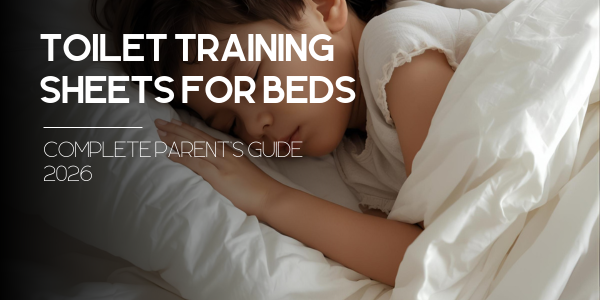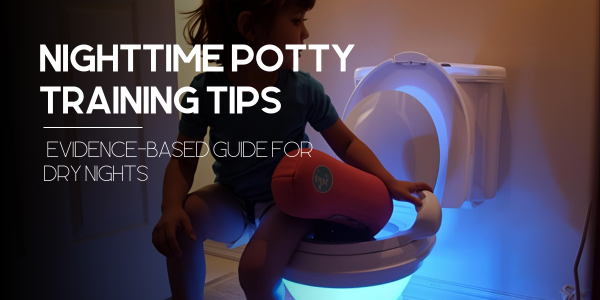Potty Training Made Simple: Daytime Wins & Dry Nights
Potty Training Made Simple: Daytime Wins & Dry Nights
No blame. No crinkly rubber. Just clear steps, cozy sleep, and confidence that sticks.
TL;DR — Quick Game Plan
“Simple” isn’t a sprint; it’s a system. Nail daytime readiness with calm routines, then decouple night dryness—because bedwetting is a different, very common sleep-stage challenge. Expect progress, not perfection. Use quiet, washable layers to protect sleep (and sanity), and add an alarm or talk with your clinician if you need a boost. Confidence is the KPI.
Pro tip: Your environment is half the battle. Quiet gear → fewer wake-ups → more patience tomorrow.
Daytime Potty Training: Readiness Over Rushing
Think cues, not calendars. Most kids show readiness between 18–36 months, but the real signal is skill stacking: noticing the urge, telling you, getting to the potty, and staying proud after the flush.
Readiness Signals You Can Trust
- Dry intervals of ~2 hours
- Follows simple steps (“pants down, sit, wipe, flush, wash”)
- Shows interest in the bathroom & independence streaks
- Poops are soft and regular (constipation derails training fast)
Design the Environment
Small potty, feet supported, books nearby. Use routine sits after meals (the gastro-colic reflex is your friend). Praise the process, not the outcome.
Deep-dive into the materials and design wins on our science-backed materials.
What to Say (and Not Say)
Scripts beat stress. Try: “Your body’s learning. We notice, we go, we try.” Drop blame, skip shaming. If accidents happen, we reset—no drama.

Nighttime Bedwetting ≠ Failed Potty Training
Night dryness is a different skill set. Sleep arousal thresholds, bladder capacity, and nighttime urine production all play a role. Many kids who crush daytime still need time at night—totally normal.
Reduce Friction with Quiet Protection
Crinkly plastic wakes kids (and you). Swap it for quiet, washable layers. Start with a comfy throw that looks like normal bedding—no stigma, easy flips at 2am.
Shop Quiet Bedwetting BlanketSleepovers & Travel: Confidence To-Go
Discreet protection protects the moment. A soft, organic sleeping bag integrates absorbency without announcing itself.
Explore Organic Sleeping BagHow to Make Nights Drier (and Calmer): A 3-Phase Plan
Dial in foundations first, then choose your tool. You’re the coach; the plan is the playbook.
Foundation (Week 1–2): Protect Sleep, Track Signals
- Hydration: front-load fluids daytime; offer sips with dinner; bathroom before lights out.
- Poop matters: soft, regular stools create bladder room. If stools are hard/infrequent, address constipation first.
- Layer the bed for fast flips—washable top layer, fitted sheet, protector.
Looking at alternatives to noisy plastics? See why rubber sheets for potty training often backfire.
Choose Your Tool (Week 3+): Alarm or Stay the Course
Enuresis alarms train wake-to-wet awareness over ~8–12 weeks. Pair with a simple script: “Hear the sound → pause → bathroom → reset gear → back to sleep.”
Ready for gear selection nuance? Our take on how bed-wetting devices work helps you match features to your child.
Troubleshoot (Anytime): Adjust Inputs, Not Expectations
- Stalls? Re-check stool patterns and sleep windows.
- Big weeks (moves, new school)? Shift to maintenance; protect sleep, pause pressure.
- New daytime wetting, pain, or snoring? Call your pediatrician.
Quiet Gear vs. Legacy Plastic: What Actually Helps at 2am
| Option | Noise Level | Absorbency | Comfort & Aesthetics | Kid Confidence |
|---|---|---|---|---|
| Traditional “rubber” sheets | High (crinkle wakes kids) | Varies | Cold/clinical feel | Low—looks “medical” |
| Basic mattress protectors | Medium | Protects mattress, not top layers | OK comfort | Medium |
| Washable, quiet throw blanket | Low (sleep-friendly) | High (top-layer absorption) | Cozy & normal bedding look | High—discreet & proud |
| Organic travel sleeping bag | Low | Integrated, on-the-go | Soft, packable, sleepover-ready | High—portable privacy |
Coaching Confidence: Scripts Kids Actually Like
Before Bed
“We’ll try, and if the bed sends us a signal, we’ll do our quick flip and go right back to cozy.”
Night Signal
“Signal heard. Bathroom break. You’re learning a grown-up skill. Back to sleep.”
Morning Debrief
“You followed the plan. That’s progress.” Reward the process, not “dryness.”
Planning a sleepover? This discreet checklist keeps the vibe chill. See our parent guide on how to talk to kids about bedwetting.
Quick Wins Tonight
Layer the Bed
Top: quiet washable throw → fitted sheet → protector. Flip, toss, sleep.
Laundry questions later? Peek at our mattress cleanup guide.
Routine Sits
Toilet after dinner and right before lights out. Short, predictable, pressure-free.
Track, Don’t Judge
One line per night: “signal/no signal,” “flip/no flip.” Trends > single nights.
Resource Hub: Level Up Your Leak-Less Strategy
We curated reader favorites—cost breakdowns, science explainers, and confidence-first guides. Click, learn, move forward.
Make a smart choice for your wallet and the planet.
Noise, discomfort, stigma—there’s a better way.
Design details that help kids sleep through.
Science-backed laundry strategies that actually work.
Normalize, plan, progress.
Quiet layers that respect dignity.
Turn chaos into routine with the right top layer.
Quiet matters—here’s why.
Play-based habits for daytime wins.
Placement, layering, and laundering—done right.
Comfort, cost, and carbon aligned.
Fiber stacks, absorbency metrics, and skin kindness.
What to use instead—without drama.
Upgraded tech for upgraded sleep.
Invisible help when kids need it most.
Practical shifts to make this the last season.
Curated, quiet, kid-approved picks.
Small upgrade, big nights.
Step-by-step, no harsh residue.
Dignity + discretion for older kids.
Quiet protection that respects your home aesthetic.
And here’s how to help—without shame.
Daytime support that blends into life.
Yes, you can keep living your life.
Quiet and comfy wins bedtime.
Potty Training Made Simple FAQ: Real Questions Parents Ask (and Straight Answers)
How long does potty training take?
It varies. Expect a few weeks for daytime consistency once your child is truly ready. Night dryness follows its own timeline—months to years is normal.
Is night training necessary or will it come naturally?
Many kids become dry at night without active training. If bedwetting stresses your child or family, consider quiet protection now and an alarm later.
Should I limit fluids in the evening?
Front-load hydration daytime; offer reasonable sips with dinner. Avoid severe restriction—it can backfire and isn’t comfy for kids.
What’s the best gear to start with?
Begin with a quiet, washable top layer that looks like normal bedding. Explore the game-changer sheets overview and pick what fits your routine.
Where do I find everything in one place?
Browse our curated lineup of quiet, washable solutions in the collections.
Confidence First: End the Stigma, Keep the Progress
Normalize It
Many kids still wet at 5–7. Your job is to protect sleep and self-esteem while the brain-bladder connection matures.
Stories help. Borrow hope from our community’s bed-wetting stories.
Skin Kindness
Skip scratchy plastics. Gentle fibers + breathable layers prevent irritation and red marks.
Sensitive skin? See how incontinence pads for sensitive skin keep calm.
When Stress Spikes
New schools, moves, growth spurts—bedwetting can blip. Support, don’t escalate. Protect sleep; lower pressure.
On the adult side, read: stress & adult bedwetting.
Make Potty Training Simple—Tonight
Protect sleep, protect confidence, protect momentum. That’s the whole play.
Quiet, Washable, Kid-Approved
Swap noisy plastic for a cozy layer that looks like real bedding. Night vibes stay normal; cleanup stays easy.
Shop Quiet Bedwetting BlanketConfidence That Travels
Sleepovers, trips, grandparents’ house—go anywhere with discreet, organic protection built in.
Shop Organic Sleeping Bag







Leave a comment